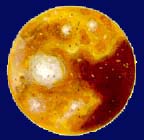Callisto
Battered Moon of Jupiter
- The most distant of the four moons discovered by Galileo.
- Equatoral diameter is 88,700 miles (142,700 km).
- Polar diameter is 82,900 miles (133,400 km).
- Average distance from Jupiter is 1.882.600 km.
- Time for one revolution about Jupiter is 16 days 16 hours.
- Composed of ice and carbonaceous silicates
- A slightly smaller "sister" to Ganymede.
- Keeps one face to Jupiter, as do both Ganymede and Earth's own moon.
- Surface almost completed covered with old craters.
- Craters are unbroken by eruptions of fresh ice.
- Internal geological activity seems to be lacking.
- Crust with scattered bull's-eye impact craters with concentric circles.
- Bulk density is greater than ice, indicative of a rocky component.
- Callisto is about half ice and half black, carbon-rich rock or soil.
- Concentrations of dark soil evident where asteroids have struck the moon.
- Bright scars remain exposing underlying ice.
- Relief of Callisto rarely more than one kilometer:
- Multi-ringed craters are virtually level.
- Larger craters are shallow, also indiciative of ice component.
- Originally deep basins, larger impact sites filled with ice flows.
- Profiles of smaller craters remain almost unchanged.
- Callisto is affected by Jupiter's forces - under constant stress from repeated stretching and heating tidal forces.
- A survivor of the planet-forming era of our Galaxy with minimal internal modifications.
|



